
225 Wilshire Ave SW, Concord NC, 28025 Phone: 800-230-0319 Email: [email protected] Web: safewaze.com Fax: 704-262-9051
II I I I
User Instructions
for Connectors
ANSI Z359.12
This manual is intended to meet the manufacturer’s instructions as
required by ANSI Z359 and should be used as part of an employee
training program as required by OSHA.
WARNING
This product is part of a personal fall arrest, work positioning, or rescue system. The manufacturer’s instructions must be provided to users of this
equipment. The user must follow the manufacturer’s instructions for each component of the system. The user must read and understand these instructions
before using this equipment. Manufacturer’s instructions must be followed for proper use and maintenance of this equipment. Alterations to this product,
misuse of this product, or failure to follow instructions may result in serious injury or death.
IMPORTANT
Questions regarding the use, care, or suitability of this equipment for your application? Contact Safewaze.
IMPORTANT
Record identication information before using this product. Identication information may be found on the equipment label (see page 11). This information
should be recorded in the “Inspection Log” located at the back of this manual (p 10).
Do not throw away these instructions!
Read and understand these instructions before using equipment!
User Information
Date of First Use:
Serial#:
Trainer:
User:
INTRODUCTION
Thank you for purchasing an Safewaze fall protection connector. This manual must be read and understood in its
entirety, and used as part of an employee training program as required by OSHA or any applicable state agency.
This manual and any other instructional material must be available to the user of the equipment. The user must read
and understand these instructions or have them explained to them before using this equipment. The user must read
and follow the manufacturer’s instructions for each component or part of the complete system. Manufacturer’s
instructions must be followed for proper use and maintenance of this product. Alterations or misuse of this product, or
failure to follow instructions may result in serious injury or death.
APPLICABLE SAFETY STANDARDS
When used according to instructions, connectors included in this manual meet all applicable ANSI Z359.12 standards
and OSHA regulations for fall protection. Applicable standards and regulations depend on the type of work being done,
and may include state-specic regulations. Refer to local, state, and federal (OSHA) requirements for additional
information concerning the governing of occupational safety regarding Personal Fall Arrest Systems (PFAS).
WORKER CLASSIFICATIONS
Understand the denitions of those who work in proximity of or may be
exposed to fall hazards.
Qualied Person: “Qualied” means one who, by possession of a recognized degree, certicate, or professional
standing, or who by extensive knowledge, training, and experience, has successfully demonstrated his ability to solve
or resolve problems relating to the subject matter, the work, or the project.
Competent Person: “Competent person” means one who is capable of identifying existing and predictable hazards
in the surroundings or working conditions which are unsanitary, hazardous, or dangerous to employees, and who has
authorization to take prompt corrective measures to eliminate them.
Authorized Person: “Authorized person” means a person approved or assigned by the employer to perform a
specic type of duty or duties or to be at a specic location or locations at the job site.
It is the responsibility of a Qualied or Competent person to supervise the job site and
ensure safety regulations are complied with.
PRODUCT SPECIFIC APPLICATIONS
Purpose: Safewaze connectors are designed to be used as part of a Personal Fall Arrest System (PFAS).
- A competent person shall train users on this equipment in accordance with OSHA and ANSI.
- Never exceed a free fall distance of 6 ft. A free fall of more than 6 ft could cause excessive
arrest forces that could result in serious injury or death.
- All Safewaze connectors have a maximum capacity of 420 lbs including any tools, clothing,
accessories, etc..., unless otherwise rated by Safewaze.
- Anchorages for attachment of Safewaze connectors shall support a minimum of
5,000 lbs or be designed with a safety factor of two by a Qualied Person.
- All Safewaze connectors must IMMEDIATELY be removed from service if subjected to fall
arrest forces.
- Safewaze connectors shall be inspected by the end user prior to each usage and
by a Competent Person other than the user at least annually. These annual inspections shall
be documented.
- Safewaze connectors are designed to be used as anchorage connectors or connectors for fall
arrest, restraint, work positioning, suspension, or rescue systems. THEY ARE NOT TO BE USED
FOR MATERIAL HANDLING
Lanyard Length
(6’ Total)
Deceleration
distance (3.5’ total)
Height of harness dorsal
D-ring from
worker’s feet
(6’ total)
Safety factor
(2’ total)
Required
distance
from
Anchorage
(17.5’ total)
Fall Clearance: There must be sucient clearance below the anchorage connector to arrest a fall before the user
strikes the ground or an obstruction. When calculating fall clearance, account for a MINIMUM 2’ safety factor,
deceleration distance, user height, length of lanyard/SRL, and all other applicable factors. (See Figure 1)
LIMITATIONS
Fall Clearance Diagram
***Diagram shown is an example
fall clearance calculation ONLY.
For all applications: worker weight capacity range
(including all clothing, tools, and equipment) is 130-310 lbs
FIGURE 1
Swing Falls: Prior to installation or use, make considerations for eliminating or minimizing all swing fall hazards.
Swing falls occur when the anchor is not directly above the location where a fall occurs. Always work as close to in
line with the anchor point as possible. Swing falls signicantly increase the likelihood of serious injury or death in the
even of a fall. (See Figure 2)
A
FALL-ARREST
S
W
I
N
G
F
A
L
L
COMPATIBILITY OF CONNECTORS
Connectors are compatible with connecting elements when they have been designed to work together in such a
way that their sizes and shapes do not cause their gate mechanisms to inadvertently open regardless of how they
become oriented. Connectors (hooks, carabiners, and D-rings) must be capable of supporting at least 5,000 lbs.
(22.2 kN). Connectors must be compatible with the anchorage or other system components (see Figure 4). Do not
use equipment that is not compatible. Non-compatible connectors may unintentionally disengage (see Figure 3).
Connectors must be compatible in size, shape, and strength. Self-locking snap hooks and carabiners are required by
ANSI Z359 and OSHA guidelines. Contact Safewaze if you have any questions about compatibility.
FIGURE 3 - UNINTENTIONAL DISENGAGEMENT
Non-compliant part
3 - gate opens
2 - gate presses
against
non-compliant
part
4 - and parts
disengage.
1 -
NOTE: SOME SPECIALITY CONNECTORS HAVE ADDITIONAL
REQUIREMENTS. CONTACT Safewaze WITH QUESTIONS.
WARNING: Do not alter or intentionally misuse this equipment. Some subsystems and
component combinations may interfere with the operation of this equipment.
WARNING: Consult with your doctor prior to use of this equipment if there is reason to doubt
your tness to safely absorb fall arrest forces in the event of a fall.
FIGURE 2
FIGURE 4 - INAPPROPRIATE CONNECTIONS
MAKING CONNECTIONS
Safewaze Snap hooks and carabiners are self closing/self locking. Ensure all connections are compatible in size,
shape and strength. Do not use equipment that is not compatible. Ensure all connectors are fully closed and locked.
Safewaze connectors (snap hooks and carabiners) are designed to be used only as specied in each product’s user’s
instructions. See gure 4 for examples of inappropriate connections. Do not connect snap hooks and carabiners:
• To a D-ring to which another connector is attached.
• In a manner that would result in a load on the gate (with the exception of tie back hooks). NOTE: Large snap hooks
must not be connected to objects which will result in a load on the gate if the hook twists or rotates.
NOTE: Large throat snap hooks must not be connected to standard size D-rings or similar objects
which will result in a load on the gate if the hook or D-ring twists or rotates, unless the snap hook
complies with ANSI Z359.1-2007 or ANSI Z359.12 and is equipped with a 3,600 lb (16 kN) gate.
Safewaze Connectors are tested to Z359.12 specifcations and meet the requirements regarding gate
ratings of 3,600 lbs. to include side load testing. Check the marking on your snap hook to verify that it
is appropriate for your application.
• In a false engagement, where features that protrude from the snap hook or carabiner catch on the anchor, and
without visual conrmation seems to be fully engaged to the anchor point.
• To each other.
• By wrapping the web lifeline around an anchor and securing to lifeline except as allowed for Tie Back models (see
section 4.5).
• To any object which is shaped or sized in a way that the snap hook or carabiner will not close and lock, or that
roll-out could occur.
• In a manner that does not allow the connector to align properly while under load.
CONNECTION
Snap Hooks: Safewaze Snap Hooks/Rebar Hooks are self closing/self locking connectors. The snap hooks provide
an eye for permanent attachment of a lifeline or lanyard.
Carabiners: Safewaze self locking Carabiners are self closing/self locking connectors. Some versions include a pin
that may be used to retain or isolate a connected lanyard or lifeline.
Using a connector that is undersized or irregular in shape (1) to connect a snap hook or carabiner could allow the
connector to force open the gate of the snap hook or carabiner. When force is applied, the gate of the hook or carabiner
presses against the non-compliant part (2) and forces open the gate (3). This allows the snap hook or carabiner to
disengage (4) from the connection point.
PHYSICAL AND ENVIRONMENTAL HAZARDS
Use of Safewaze connectors in areas with physical or environmental hazards may require addtional precautions to
reduce the possibility of injury to the user or damage to the equipment. These hazards may include, (not limited to):
heat, severe cold, chemicals, corrosive environments, high voltage, power lines, gases, moving machinery, and sharp
edges.
CORROSION
Use of Safewaze connectors near seawater or other corrosive environments will require DAILY cleaning in order to
ensure corrosion damage is not aecting the performance of the connector.
CHEMICAL HAZARDS
Use of Safewaze connectors in the vicinity of solutions containing acid or caustic chemicals, especially at elevated
temperatures, may cause damage to connectors. Increased cleaning and and inspection of connectors is
recommended.
ELECTRICAL HAZARDS
Do not install Safewaze connectors where they, or the user, may come into contact with electrical power lines.
TRAINING
Safewaze connectors are intended to be installed and used by persons who have been properly trained
(as per ANSI / OSHA) in their correct application and use.
OPERATION AND USE
COMPATIBILITY
Safewaze connectors must be connected to a compatible connection (i.e. compatible D-ring). Failure to do so could
cause disengagement (roll-out), or damage to the connector. Self locking connectors reduce, but cannot eliminate, the
possibility of roll-out.
CAPACITY
Safewaze connectors are designed for use by persons with a combined weight weight (person, clothing, tools, etc.) of
no more that 420 lbs. Only one personal protective system may be connected to the connectors/anchorage connectors
at any time.
Personal fall arrest systems used with Safewaze connectors must be rigged/installed in such a manner as to limit free
fall as per ANSI / OSHA requirements.
MANUAL-CONNECT

225 Wilshire Ave SW, Concord NC, 28025 Phone: 800-230-0319 Email: [email protected] Web: safewaze.com Fax: 704-262-9051
II I I I
CONNECTOR APPLICATIONS
INSPECTION
FREQUENCY:
- Before each use, visually inspect according to the steps listed below.
- The Safewaze connector must be inspected by a competent person (as dened by ANSI, OSHA, guidelines),
other than the user, at least annually. Record results of each formal inspection in the inspection log at the back of this
manual.
INSPECTION STEPS:
STEP 1: Inspect the Safewaze connector for damage. Pay particular attention for cracks, sharp edges, burrs, dents, or
deformities. Check for bending or distortion.
STEP 2: Inspect the Safewaze connector for excessive corrosion. The gate and lock should operate smoothly, with no
diculty. Gates must fully close and engage nose of hook/carabiner.
STEP 3: Inspect markings. Markings should be present and fully legible.
STEP 4: Inspect each system component or subsystem according to manufacturer’s instructions.
STEP 5: Record the inspection date and results in the inspection log.
*** If the inspection reveals a defective condition, remove the unit from service and destroy.
IMPORTANT: If this equipment has been subjected to a fall arrest or impact forces, it must be immediately removed
from service and destroyed.
MAINTENANCE & SERVICING
WARRANTY
If gate operation is sluggish, apply small amount of WD-40 or similar moisture repellent lubricating agent to the hinge
end of the carabiner / hook gate ONLY. Remove excess with a clean, dry cloth. If carabiner / hook still does not function
properly, remove from service and destroy.
Safewaze warrants its products are free from defects in materials and construction under normal use and service.
Liability is not accepted for abuse, modication, improper use, destructive activity and contaminated exposure.
Personal Fall Arrest: Safewaze connectors approved for Personal Fall Arrest applications as part
of a Personal Fall Arrest System (PFAS). The structure to which the connector is attached must
withstand loads applied in the directions permitted by the system of at least 5,000 lbs. Maximum
allowable free fall is 6’. For Fall Arrest applications, the only allowable attachment point to harness
for Safewaze connectors is the Dorsal D-ring.
Restraint: Safewaze connectors are authorized for use in Restraint applications. The structure to
which the connector is attached must withstand loads applied in the directions permitted by the
system of at least 1,000 lbs NO free fall is permitted. Restraint systems may only be used on
surfaces with slopes up to 4 / 12 (vertical / horizontal). For Restraint applications, the allowable
attachment points to harness are Dorsal D-ring, Chest D-ring, Side D-rings, and Shoulder D-rings.
Work Positioning: Safewaze connectors are authorized for use in Work Positioning applications.
Work Positioning allows a worker to be supported during suspension while freeing both hands to
conduct work operations. The structure to which the connector is attached must withstand loads
applied in the directions permitted by the system of at least 3,000 lbs. Maximum allowable free fall
is 2’. For positioning applications, the allowable attachment points to harness are the Side D-rings.
Rescue/Conned Space: Safewaze connectors are authorized for use in Rescue/Conned Space
applications. Rescue systems are utilized to safely recover a worker from a conned location or after
exposure to a fall. Composition of rescue systems can vary based upon the type of rescue involved.
The structure to which a connector is attached must withstand loads applied in the directions
permitted by the system of at least 3,000 lbs. NO free fall is permitted. For rescue applications, the
allowable attachment points to harness are Dorsal D-ring, Chest D-ring and Shoulder D-rings.
INSPECTION LOG
Date Inspection Items
Noted
Corrective Action Initials
Safewaze
225 Wilshire Ave SW
Concord, NC 28025
PHONE: 800-230-0319
FAX: 704-262-9051
EMAIL: [email protected]
Web: safewaze.com
Steel Carabiner
Example
Steel Snap Hook
Example
Aluminum Carabiner
Example
Steel Rebar Hook
Example
BEFORE EACH USE of this equipment, carefully inspect it to assure it is in good working condition. Check for worn
or damaged parts. Inspect for sharp edges, burrs, cracks, distortion, or corrosion. Gates must close and lock. Inspect
other fall arrest or restraint equipment according to manufacturers instructions. Do not use if inspection reveals an
unsafe condition.
BEFORE EACH USE of this equipment, carefully inspect it to assure it is in good working condition. Check for worn
or damaged parts. Inspect for sharp edges, burrs, cracks, distortion, or corrosion. Gates must close and lock. Inspect
other fall arrest or restraint equipment according to manufacturers instructions. Do not use if inspection reveals an
unsafe condition.
PLAN your fall arrest system before starting your work. Consider all factors aectin your safety during use.
SHARP EDGES
Avoid working where the connecting subsystem or other system components may come in contact with unprotected
sharp or abrasive edges. If working near sharp edges is unavoidable, protection against cutting must be used.
SNAP HOOK OPERATION
To connect the snap hook to the connection point, depress the locking mechanism with index nger an pull back gate
with thumb
CARABINER OPERATION
To connect the carabiner to the connection point, rotate the gate clockwise and push to the center of the carabiner.
Some Safewaze carabiners have a triple locking mechanism and must be pulled up before rotating the gate in a
clockwise motion. When positioned around an anchorage point, release the gate to close and lock the carabiner.
TRAINING
It is the responsibility of the users of this equipment to understand these instructions and to be trained in the correct
installation, use, and maintenance of this equipment (as per ANSI, OSHA, and applicable state, provincial and federal
requirements.) This user manual is not a substitute for a comprehensive training program. Training must be provided on
a periodic basis (as per ANSI, OSHA, and applicable state, provincial and federal requirements) to ensure prociency
of the users.
RESCUE
When using this equipment, a rescue plan must be in place as well a a means to implement it and communicate that
plan to users, authorized persons, and rescuers.
AFTER A FALL
Any equipment which has been subjected to the forces of arresting a fall must be removed from service immediately
and destroyed.
RETAINING PIN INSTALLATION
Some Safewaze connectors are supplied with a pin, that when installed provides a captive eye for connection of a
lanyard, lifeline, or similar component. To install the roll pin, drive the pin into the pre-drilled hole in the back bar of
the carabiner using a punch. The open side of the roll pin should be facing away from the lanyard or lifeline material.
Continue driving the pin through the back bar and into the front bar until pin is ush on the outside of the back bar.
WARNING: Follow the manufacturer’s instructions for associated equipment (full body
harness, lanyard, lifeline etc.) used in your personal all arrest system.
OPERATION
-
 1
1
-
 2
2
SafeWaze FS1025 Owner's manual
- Type
- Owner's manual
Ask a question and I''ll find the answer in the document
Finding information in a document is now easier with AI
Related papers
-
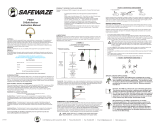 SafeWaze FS887 Owner's manual
SafeWaze FS887 Owner's manual
-
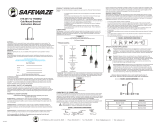 SafeWaze 019-4017 Owner's manual
SafeWaze 019-4017 Owner's manual
-
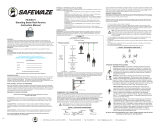 SafeWaze FS-EX311 Owner's manual
SafeWaze FS-EX311 Owner's manual
-
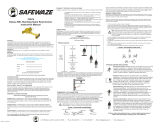 SafeWaze FS874 Owner's manual
SafeWaze FS874 Owner's manual
-
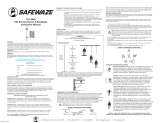 SafeWaze 021-4043 Owner's manual
SafeWaze 021-4043 Owner's manual
-
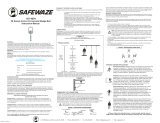 SafeWaze 021-4054 Owner's manual
SafeWaze 021-4054 Owner's manual
-
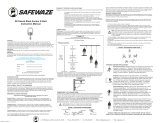 SafeWaze 021-4047 Owner's manual
SafeWaze 021-4047 Owner's manual
-
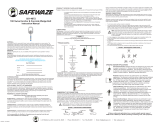 SafeWaze 021-4072 Owner's manual
SafeWaze 021-4072 Owner's manual
-
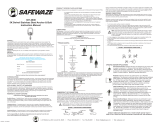 SafeWaze 021-4045 Owner's manual
SafeWaze 021-4045 Owner's manual
-
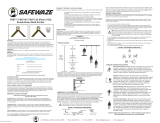 SafeWaze FS871N Owner's manual
SafeWaze FS871N Owner's manual
Other documents
-
Guardian G-Link Dual Retractable SRL Operating instructions
-
3M Protecta® Retracting Lifeline 3100414, Web, Twin legs, Thermoplastic Housing, Rebar Hooks, 6ft (1.8m) Operating instructions
-
3M PROTECTA® PRO™ Pack Pack 420 lbs. Capacity Shock Absorbing Lanyard 1341011, Red, 6 ft. (1.8m), 1 EA/Case Operating instructions
-
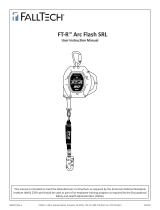 FallTech 721530TD1 User manual
FallTech 721530TD1 User manual
-
3M PROTECTA® Rebel™ Self Retracting Lifeline, Web 3100432, 1 EA Operating instructions
-
3M DBI-SALA® Nano-Lok™ Aerial Work Platform Self-Retracting Lifeline, Web 3101655, Blue, 4.5 ft. (1.4m), 1 EA Operating instructions
-
3M DBI-SALA® Lad-Saf™ Mobile Rope Grab 5000335, 1 EA Operating instructions
-
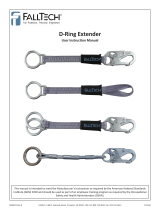 FallTech D-Ring Extender User Instruction Manual
FallTech D-Ring Extender User Instruction Manual
-
3M PROTECTA® PRO™ Mobile Rope Grab 5000003, 1 EA Operating instructions
-
3M Protecta® Rope Grab Safety System Operating instructions













